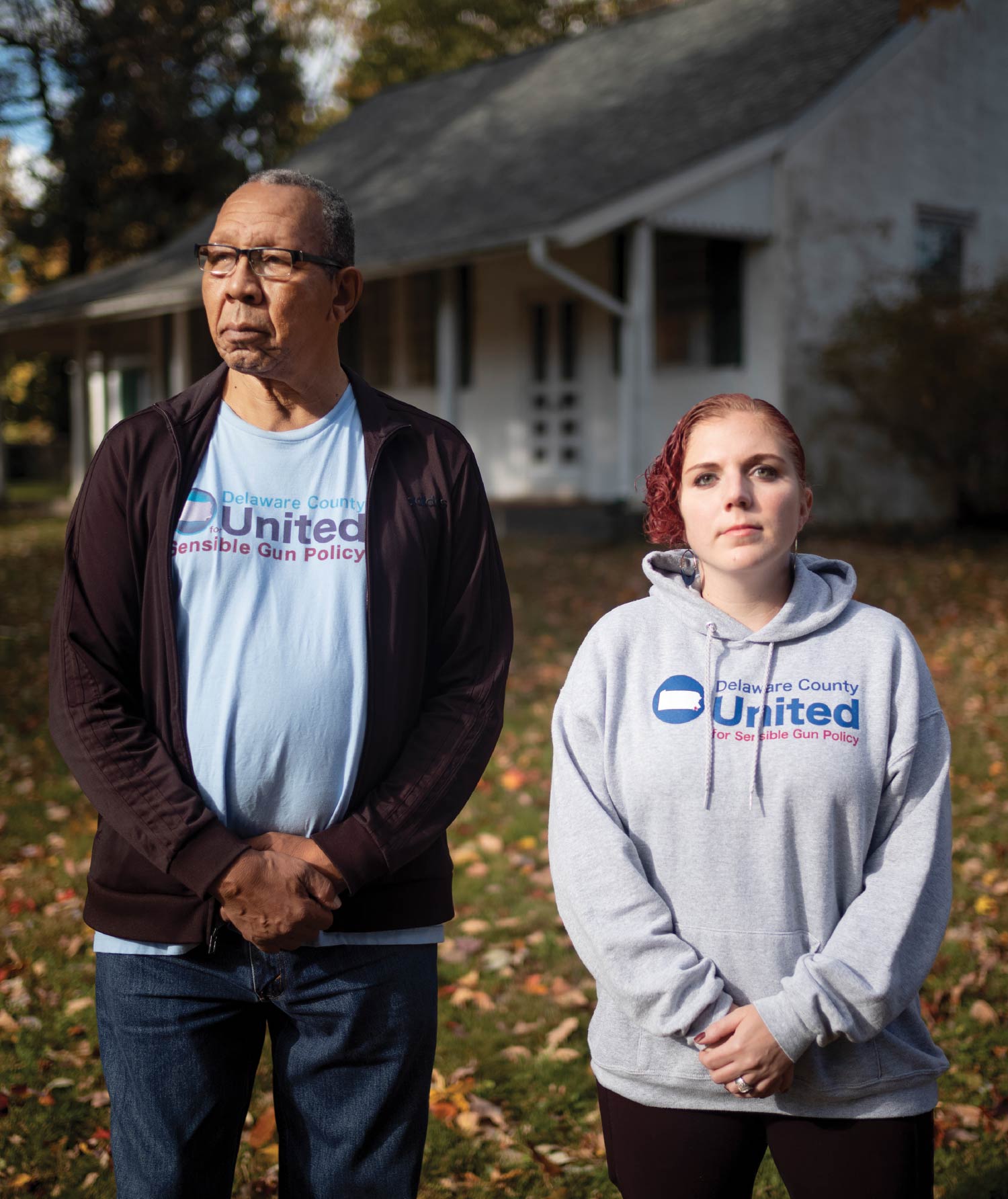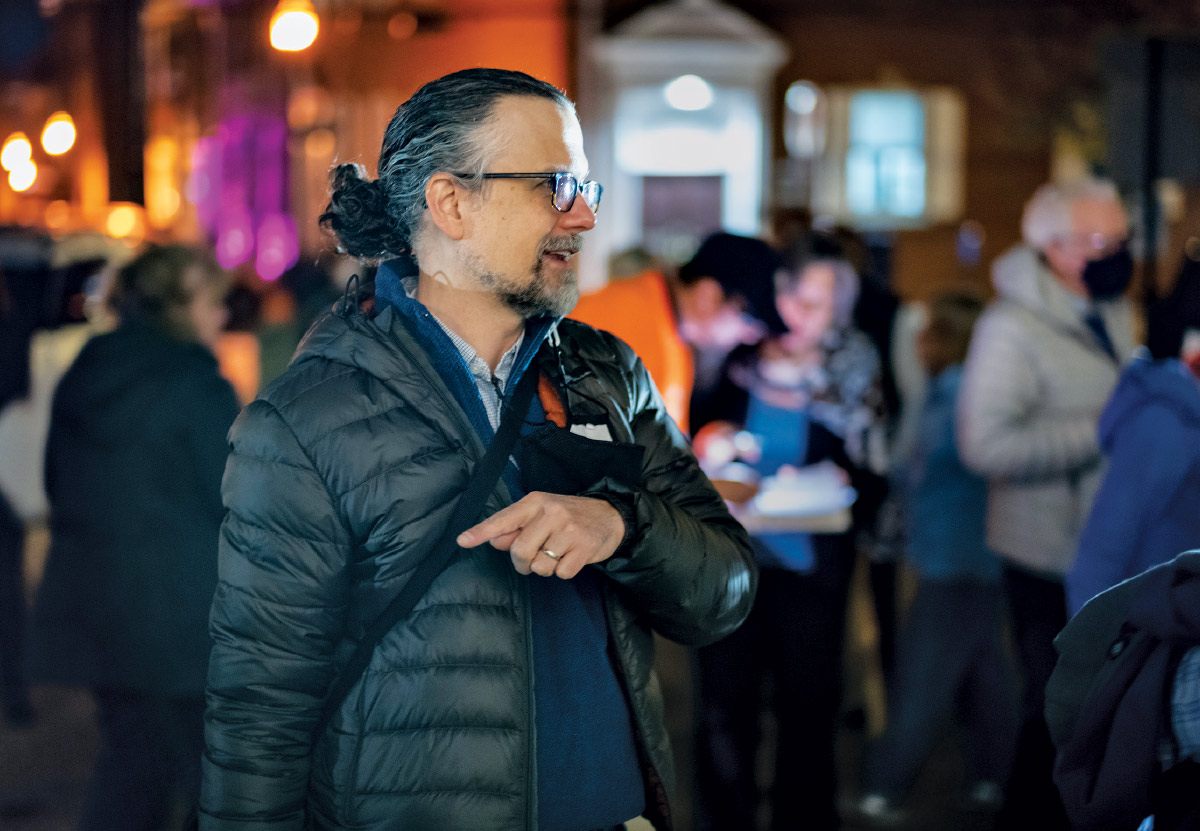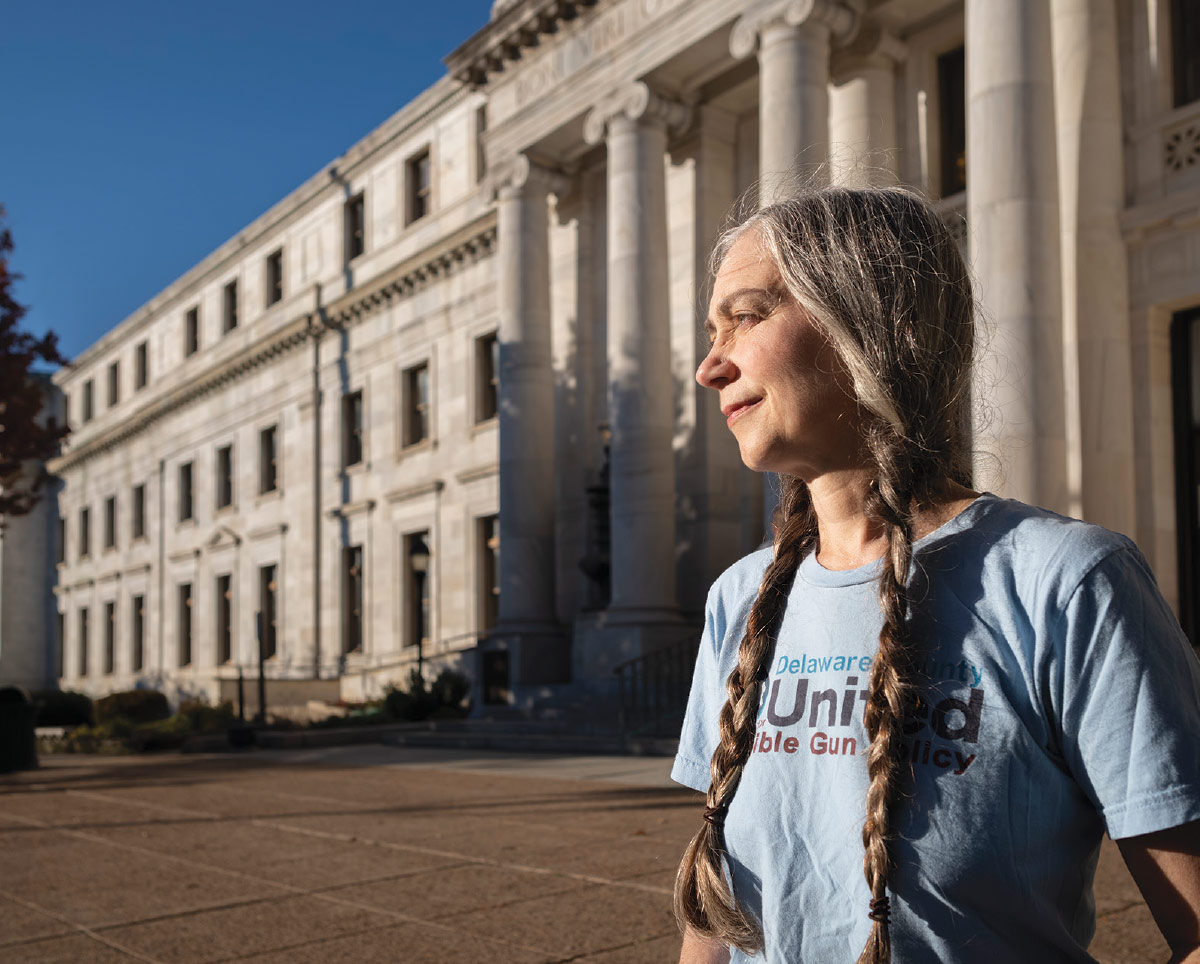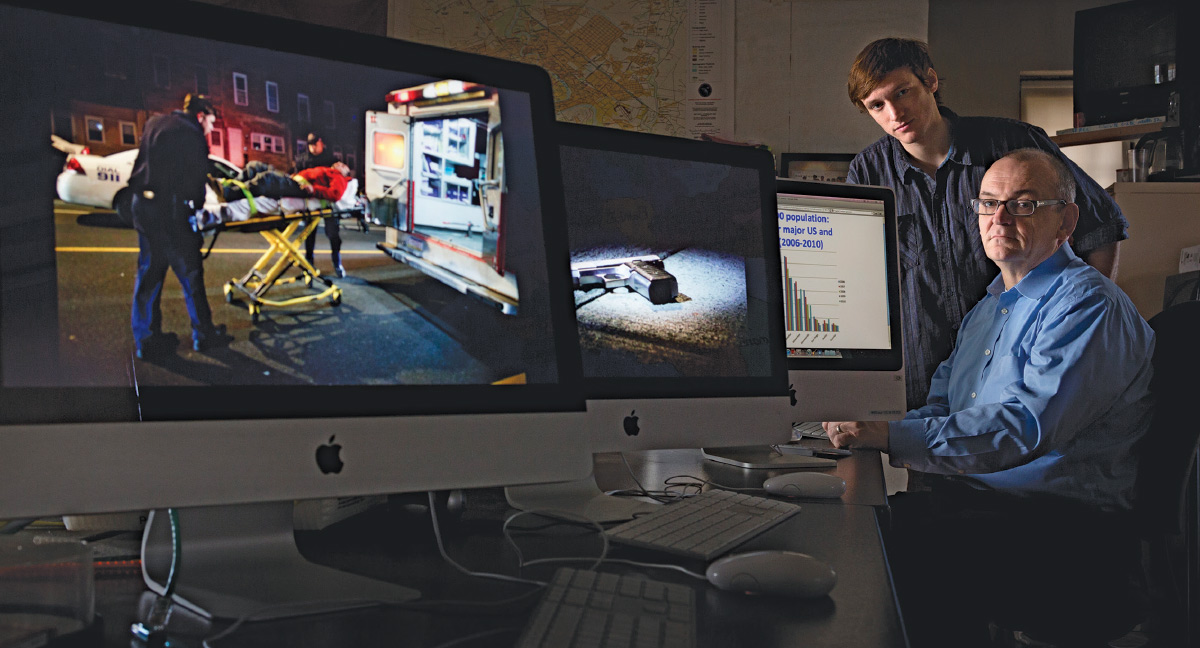Partners in Peacebuilding
photos by Laurence Kesterson

Of a family searching for answers or justice. Of a community rallying for resources in response to senseless shootings. Of a loved one lost to gun violence.
Those stories often go unheard in the greater narrative of gun violence. As mass shootings and other high-profile crimes dominate headlines, community violence tends to get pushed aside as an unfortunate reality of American life.
A Swarthmore project is trying to alter that narrative. Launched this fall, the Delaware County Homicide Database (delcohomicides.swarthmore.edu) is an online dashboard and interactive map that tracks all violent deaths in Pennsylvania’s fifth-most-populous county, the vast majority of which are firearm-related. Created by students under the guidance of Professor of Peace & Conflict Studies and Sociology Lee Smithey, the database aims to assist in the prevention of gun violence while painting a fuller picture of the effects of firearms.
The project is a peacebuilding effort in partnership with advocacy groups, Smithey says — developed in collaboration with members of the local community, and informed by their personal experiences.
“When I look at that map, I probably tend to see it as a sociologist first, and I start thinking about proximity to the interstate, the income level in these various neighborhoods, etc.,” says Smithey, who is also coordinator of Swarthmore’s Peace & Conflict Studies Program. But residents of areas where gun violence is pervasive, he says, “see a mosaic of stories and individuals and people, and they know that many of these homicide events are related to one another. It opened our eyes to how this information is going to tell a different story to different people.”
A systemic problem
In Delaware County, the Swarthmore database shows, 28 homicides were recorded in 2019, the most recent year for which local statistics are available. The map accompanying the data illuminates hot spots in lower income and more highly populated parts of the county, in line with trends for community gun violence nationwide.
For years, local anti-violence organizations have worked to draw attention to the issue, in hopes of advancing state gun legislation and bringing interventions to the areas that need it most. But data collection can be a challenge for the groups’ volunteers, as they balance full-time jobs with their advocacy work. “It’s really hard to go and ask for resources when you don’t have the backup data,” says Jess Frankl of Delaware County United for Sensible Gun Policy, or Delco United, a legislation-focused advocacy group that partnered with Smithey and his students on the database project.
The dashboard has elevated the conversation. “It helps a group like ours to go to our elected representatives and say, look, you know there’s a problem — the numbers do not lie,” says Frankl. “Here’s where the problem is and here’s who it’s hitting and here’s what you’re not doing to fix it.”
The statistics also help proponents as they engage with members of their own communities — or with those who are against their cause, adds John Linder, who co-chaired Delco United with Frankl from 2018 to 2021. (The nonprofit, which was co-founded by Robin Lasersohn ’88 and her husband, Terry Rumsey, became a chapter of the statewide organization CeaseFirePA early last year.)
“We have to get accurate data, share it with people from the community, and teach what it means,” says Linder, a professor at Delaware County Community College who served as mayor of Chester, Pa., from 2012 to 2016. “If we educate, we have a chance to eliminate. If we educate, we have a chance to motivate. If we bring to people’s awareness what is bothering them, we’ve got the greatest chance of them taking the medicine that is prescribed for them.”

“We tried our best to give our community partner organizations the most information they can possibly get in order to do their job better and make our communities safer,” says Oliver Hicks ’22, a political science and peace & conflict studies major from San Luis Obispo, Calif., who worked on the project. “Gun violence is not a series of isolated incidents. It’s a systemic problem of pandemic-level proportions.”

Humanizing the victims
The project drew inspiration from the work of photojournalist, activist, and educator Jim MacMillan, who launched a similar site tracking gun deaths in Philadelphia. A former journalist-in-residence with Swarthmore’s War News Radio and former manager for media and responsibility for the Lang Center for Civic and Social Responsibility, MacMillan is the founding director of the Philadelphia Center for Gun Violence Reporting, which emphasizes the importance of including community voices in the coverage of fatal shootings.
Community organizing is just in our blood
A preschool teacher at the time of the 2012 massacre, which left 26 young children and educators dead at a school in Newtown, Conn., Lasersohn found herself wondering what she could have done in that situation to protect herself and her students.
Not willing to sit idly by, Lasersohn took a stand. With her husband, Terry Rumsey, she co-founded Delaware County United for Sensible Gun Policy, in hopes of effecting positive change at the legislative level.
“Terry and I had been concerned about gun policy and gun violence in the U.S. for many, many years,” says Lasersohn, a Media, Pa., resident who has been engaged in local activism since her days at Swarthmore, where she special-majored in education and social change. The pair attended the Million Mom March in 2000 and were tuned in to firearm issues, she says, but Sandy Hook truly mobilized the anti-gun-violence movement nationwide.
Launched in 2013, Delco United has pushed for bipartisan support of firearm legislation at the state and federal level, including universal background checks for gun purchases and bans on high-capacity ammunition magazines. It has also encouraged participants not to tiptoe around the issue of gun control or to be afraid to call out the NRA.
“When we first began organizing, a lot of folks on the gun-sense side of things were scared to be direct and bold in their demands,” Lasersohn says. “Through a lot of strategic planning and organizing, the people experienced their own collective power. We transformed that attitude into one of like, dammit, you’re going to start listening to the majority of the community here. We want some basic, commonsense solutions, and we’re not going to be fearful and back down.”
Once, Lasersohn says, during a unity walk of about 100 people from Chester to Media, Delco United was met by roughly 25 armed counterdemonstrators who tried to shout them down. Instead of engaging with them, Lasersohn and her group marched on by, singing “We Shall Overcome.”

Having accomplished their first-stage organizational goals with Delco United, Lasersohn and Rumsey passed the leadership baton to Jess Frankl and John Linder in 2018. The move freed them up to focus more on other priorities, including Green Seeds, their grant-writing consultancy that supports organizations doing work that benefits the greater good. Among Lasersohn’s clients are the Swarthmore-backed Chester Children’s Chorus, as well as Historic Fair Hill, a Quaker nonprofit directed by Jean Murdock Warrington ’71.
Green Seeds “meets our need to have right livelihood, to feel like the way we earn a living is also helping to change and heal the world,” Lasersohn says. And it allows the couple to continue making change in the community, through open-space preservation advocacy, continued support for the anti-gun-violence movement, and other efforts close to their hearts. “I was not an activist before I came to Swarthmore, but I think I was itching to be one,” she says. “Community organizing is just in our blood.”
“For me, the course was really about humanizing both the living and, unfortunately, deceased victims of gun violence,” says Aleina Dume ’23, a sociology and educational studies major from Queens, N.Y., who took Gun Violence Prevention during last winter’s January term; the course is being offered again in the fall. One particularly impactful speaker for Dume was Beverly Wright, a mother from Chester who lost her son, Emein, to gun violence in 2005. In response to that tragedy, Wright formed the group Women of Strength United for Change, which provides support for families suffering similar losses and works to advance gun policy to prevent future violence.
“Hearing her story, but also about her grassroots activism, really helped me remember that these are lives that we’re entering into this database,” Dume says. “We might not know this person’s name, but that just speaks to how important the work is.
“As a person of color in this class, and as a woman, I think about how Black women and mothers are so often on the front lines of gun violence protests and advocacy. How can we make sure that the right voices are being uplifted?”
One way, advocates say, is simply to listen.
After consulting with community members like Wright, Smithey’s students decided against using pinpoints for each death in the database, to avoid reducing each victim to a statistic. Instead, the information is presented as a heat map, with areas growing more saturated in color as the number of cases increases.
“Having those conversations is so important, and listening is way harder than talking,” says Frankl, who is now on the board of CeaseFirePA while working for an insurance company. “For Lee to have the initiative to say, you know what, we think we know what we’re doing here, but let’s get an outside ear because these are the people really being affected, and to take that and find ways to change it — no matter how much work it might be from a tech standpoint — that was so important.”
Making connections
“I at some point would know someone in their family — a parent or an uncle or aunt that I went to college with,” says Linder, who was born and raised in Chester and attended Widener University there. “Someone once asked me, ‘Why did you put yourself through that?’ I said, ‘I didn’t put myself through anything. I did what I thought was the responsible thing to do.’

Journalist and Educator Jim MacMillan Widens View on Gun Violence
“It’s discouraging, but it only reinforces the need to do the work,” says the Pulitzer Prize-winning journalist and educator. “Once you start to view gun violence as entirely preventable, you find it impossible not to keep going.”
Informing that view are MacMillan’s 40 years of covering gun violence. He was a photographer for 17 years with the Philadelphia Daily News, taking a leave in 2004–05 to cover the Iraq War for the Associated Press in Baghdad; he later served as an editor/producer of the Gun Crisis Reporting Project in Philadelphia. Between those moves, MacMillan made a stop at Swarthmore, where he was a journalist-in-residence with War News Radio and a manager for media and responsibility for the Lang Center for Civic and Social Responsibility.
As founding director of the Philadelphia Center for Gun Violence Reporting, MacMillan explores the hypothesis that changing the way that journalists and news organizations report on gun violence can prevent shootings and save lives. That effort is rooted in the concepts of solutions journalism, trauma journalism, and, as he learned from Professor Lee Smithey, peace journalism.
“There’s a pretty straight line from my experiences at Swarthmore to what I’m doing now,” says MacMillan, who has returned several times to Smithey’s classroom as a guest speaker.
Having collected and analyzed gun-violence data in Philadelphia, which he shared through a database in 2012, MacMillan delighted in the recent efforts of Smithey and his students.
“We’re all basically flying blind without data,” MacMillan says, “and making it accessible to more people is an incredibly generous gift to the community.”
Swarthmore’s database could empower government, nonprofits, and individuals to take the collective action needed to prevent gun violence, he adds. But that’s only possible because of the deep community engagement fostered from the beginning of the project.
“Having the trust and confidence of community partners verifies that you’re doing it in a way that they think is valuable,” he says. “And it feels like the nature of this Swarthmore community that I know, its emphasis on community-building, is the secret sauce.”
As a lifelong resident, Linder understands Chester’s current challenges, including a lack of jobs, poor educational opportunities, and a high crime rate. But he also sees signs of hope for the city that he loves, including a sharp drop in shootings reported last summer, attributed partly to the Chester Partnerships for Safe Neighborhoods, a community-engagement program launched by District Attorney Jack Stollsteimer.
What outsiders don’t always realize about Chester, Linder says, “is that most of the people there abhor gun violence. We think because it happens, people outside think everybody goes for that. Everybody doesn’t go for that.”
What residents want, he says, is a safe and quiet community where everyone can live without the fear of crime. As Linder often tells opponents of firearm legislation: “I don’t want your gun. What I want is your commitment that we’re going to work together to stop people from taking our lives.”
Database in Action
“Making a Change Group Chester highlighted your map at a program pitch tonight for a new intervention initiative in Chester,” CeaseFirePA Organizing Manager Max Milkman wrote in an email to Professor Lee Smithey in December. Milkman leads the Delaware County Chapter of CeaseFirePA, Delco United. “They said your database was key to helping them understand where to invest resources.”
Continuing the Conversation
But it is also expected to be useful to trauma surgeons, public health workers, and local governments. Before the pandemic, Pennsylvania officials invited Smithey, Frankl, and Linder to Harrisburg to discuss tracking gun deaths on a statewide level. The hope is that Swarthmore’s project will inspire additional databases — created for other counties, perhaps by other colleges.
“It is just amazing how we have constantly run into leaders who want to talk about this,” Smithey says. “And it can be rewarding for students — many just took a class because they thought Gun Violence Prevention would be interesting, and then they realize we’re actually doing something that people say that they need.”
The database is also likely to evolve along with those needs. One idea is for the site to eventually include an “in memoriam” section, where loved ones could honor victims with photos and tributes. “The students are rightly interested in humanizing this data as much as possible,” Smithey says, “and so we imagine soliciting descriptions of victims by surviving family members, if they wish, in a totally voluntary way.”
That addition would only bolster the efforts of anti-gun-violence advocates, Frankl says. Never a numbers person, even during her time leading Delco United, Frankl instead felt drawn into action by the victims and survivors themselves, by their personal narratives of tragedy, perseverance, and triumph.
“It never stuck with me until I connected it to the lives being lost, until I had their stories, until I had the bigger picture of what was happening,” Frankl says. “And that’s what I love so much about how Lee did this. He didn’t rush it and say, I’m busy, I have other things to do, let’s get this up on a website. He did it with multiple classes and educated the students on the bigger scope of the problem. He brought in community members and got their point of view. It was done in the right way.”